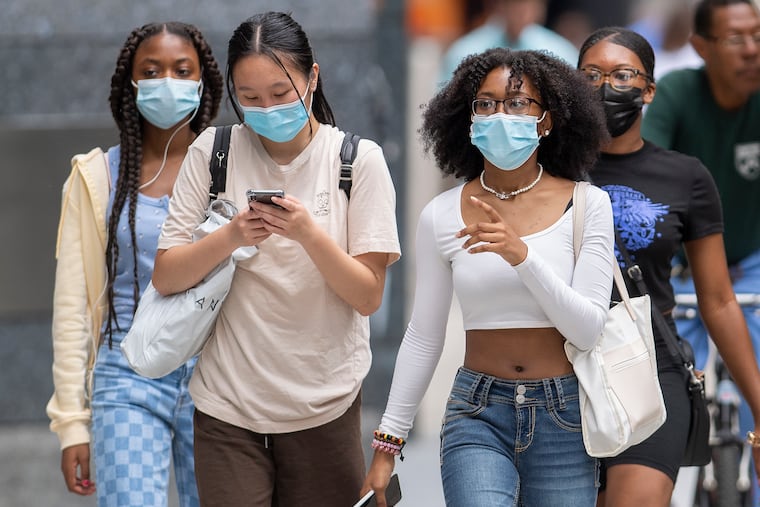Delta-plus and lambda variants don’t yet warrant panic for vaccinated people, Philly experts say
“Just because some change in the spike diminishes binding of this or that antibody, that’s only one instrument in the orchestra,” said Frederic Bushman, a professor of microbiology at Penn.

While the United States scrambles to respond to growing COVID-19 cases fueled by the delta variant, a handful of new variants are continuing to appear, such as B.1.617.2.1 or AY.1 — dubbed “delta-plus.” As its moniker suggests, delta-plus is reported to be a souped-up version of the highly prevalent and likely more transmissible delta variant.
On Tuesday, South Korean public health officials reported two cases of this new variant, including at least one person who was vaccinated, according to Reuters. This extends the list of more than 200 previously reported cases in the United States, Canada, and multiple European and Asian nations. The World Health Organization considers it to be a variant of concern.
But with very few delta-plus cases still — hundreds, compared with untold thousands of delta cases — there isn’t enough evidence to determine what additional threat the strain poses compared with previous variants, experts say.
“There’s a lot that we don’t necessarily know about it scientifically,” said Brianne Barker, an associate professor of biology at Drew University. “I don’t know that it’s a major thing for us to be worrying about right now, but we should certainly be keeping our eye on any changes that the virus is making.”
Frederic Bushman, a professor of microbiology at the University of Pennsylvania, said his team has not yet seen delta-plus in the more than 1,500 cases from Southeastern Pennsylvania and southwestern New Jersey that it has sequenced since March, when delta-plus was first described.
Because there have been so few cases nationally, the U.S. Centers for Disease Control and Prevention currently reports delta-plus cases as part of its delta counts.
When people — often unvaccinated — are infected, there’s an opportunity for the virus to make a mistake as it replicates its genetic material inside its new host. Sometimes these mistakes, known as mutations, give them a survival advantage; those mutations tend to stick around and become the basis for defining a new strain, like the delta variant.
“Each one of those changes has a possibility of maybe overcoming the vaccine,” said Zachary Klase, associate professor of pharmacology and physiology at Drexel University. “We haven’t seen that yet, but that’s the worry.”
Delta-plus has a mutation called K417N that changes its spike protein, the appendage that the virus uses to latch onto and infect lung cells. It’s not the first variant to develop this change: The beta variant has the same one.
“I think [that’s] the reason it caught people’s attention from a concern standpoint,” Klase said.
Delta-plus is expected to have the major qualities reported in the delta variant, such as increased viral load that may foster broader transmission. But the effect of this new mutation on the variant’s infectiousness is still unclear. Studies of the same mutations in older variants may give us a hint, Bushman said. In the beta variant, scientists suspected K417N and other mutations may help the virus avoid antibodies that target part of the spike protein. This meant the mutation kept some antibody-based therapies from effectively neutralizing the virus.
However, it’s important to remember that purified antibodies used to treat COVID-19 and other diseases are not the same as the more diverse mixtures of antibodies — generated either by vaccination or natural infection — in the body, Barker said. Even if the mutation shielded the virus from one antibody, other antibodies would have other targets unaffected by the mutation. This might explain reassuring reports that antibodies from vaccinated people are similarly effective at neutralizing both the delta-plus and delta variant in experiments. So far, studies show that the vaccines in the United States offer protection against the delta variant, although they may be slightly less effective than against earlier strains.
“The spike is a very large protein,” Barker said. “These changes are each changing one possible target, but they’re not eliminating that target completely.”
Moreover, the body can defend itself with more than just antibodies, Barker notes: There are also immune cells that can dispose of infected cells or target RNA or proteins that come from viruses, and variants haven’t been shown to evade these responses.
“Just because some change in the spike diminishes binding of this or that antibody, that’s only one instrument in the orchestra,” Bushman said.
Importantly, precautions like vaccination, wearing masks, and social distancing are still effective tools, Barker said.
“None of the changes will impact things like the virus’ ability to transmit when you’re wearing a mask,” Barker said. “Many of the same precautions that we’ve been using are still in effect here.”
Meanwhile, another variant — lambda, categorized by the WHO as a “variant of interest,” one step below a “variant of concern” — has been responsible for hundreds of cases in the United States. It too has mutations in the spike protein that may boost its ability to infect cells or avoid immune defenses, but these haven’t been confirmed. Bushman’s team also has not identified lambda-driven cases in the Philadelphia area.
Variants reaffirm the importance of vaccination, Klase said.
“We have a lot of protected people who the virus is presumably not growing in, and a lot of unprotected people where it’s still rapidly changing,” Klase said. “From the virologist perspective, human behavior is still the biggest factor in the spread.”